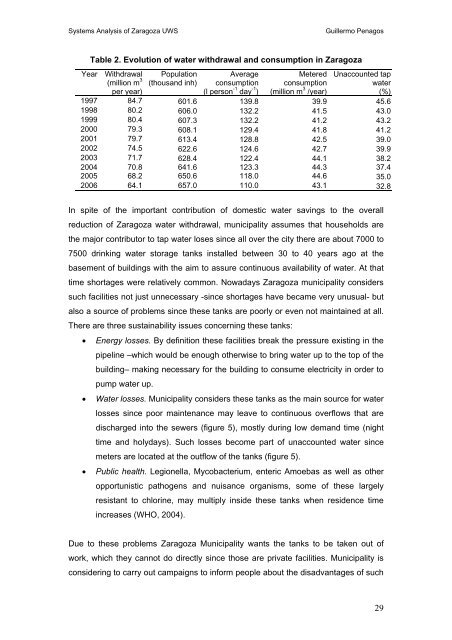Systems Analysis of Zaragoza Urban Water - SWITCH - Managing ...
Systems Analysis of Zaragoza Urban Water - SWITCH - Managing ...
Systems Analysis of Zaragoza Urban Water - SWITCH - Managing ...
Create successful ePaper yourself
Turn your PDF publications into a flip-book with our unique Google optimized e-Paper software.
<strong>Systems</strong> <strong>Analysis</strong> <strong>of</strong> <strong>Zaragoza</strong> UWS<br />
Guillermo Penagos<br />
Table 2. Evolution <strong>of</strong> water withdrawal and consumption in <strong>Zaragoza</strong><br />
Year Withdrawal<br />
(million m 3<br />
per year)<br />
Population<br />
(thousand inh)<br />
Average<br />
consumption<br />
(l person -1 day -1 )<br />
Metered<br />
consumption<br />
(million m 3 /year)<br />
Unaccounted tap<br />
water<br />
(%)<br />
1997 84.7 601.6 139.8 39.9 45.6<br />
1998 80.2 606.0 132.2 41.5 43.0<br />
1999 80.4 607.3 132.2 41.2 43.2<br />
2000 79.3 608.1 129.4 41.8 41.2<br />
2001 79.7 613.4 128.8 42.5 39.0<br />
2002 74.5 622.6 124.6 42.7 39.9<br />
2003 71.7 628.4 122.4 44.1 38.2<br />
2004 70.8 641.6 123.3 44.3 37.4<br />
2005 68.2 650.6 118.0 44.6 35.0<br />
2006 64.1 657.0 110.0 43.1 32.8<br />
In spite <strong>of</strong> the important contribution <strong>of</strong> domestic water savings to the overall<br />
reduction <strong>of</strong> <strong>Zaragoza</strong> water withdrawal, municipality assumes that households are<br />
the major contributor to tap water loses since all over the city there are about 7000 to<br />
7500 drinking water storage tanks installed between 30 to 40 years ago at the<br />
basement <strong>of</strong> buildings with the aim to assure continuous availability <strong>of</strong> water. At that<br />
time shortages were relatively common. Nowadays <strong>Zaragoza</strong> municipality considers<br />
such facilities not just unnecessary -since shortages have became very unusual- but<br />
also a source <strong>of</strong> problems since these tanks are poorly or even not maintained at all.<br />
There are three sustainability issues concerning these tanks:<br />
• Energy losses. By definition these facilities break the pressure existing in the<br />
pipeline –which would be enough otherwise to bring water up to the top <strong>of</strong> the<br />
building– making necessary for the building to consume electricity in order to<br />
pump water up.<br />
• <strong>Water</strong> losses. Municipality considers these tanks as the main source for water<br />
losses since poor maintenance may leave to continuous overflows that are<br />
discharged into the sewers (figure 5), mostly during low demand time (night<br />
time and holydays). Such losses become part <strong>of</strong> unaccounted water since<br />
meters are located at the outflow <strong>of</strong> the tanks (figure 5).<br />
• Public health. Legionella, Mycobacterium, enteric Amoebas as well as other<br />
opportunistic pathogens and nuisance organisms, some <strong>of</strong> these largely<br />
resistant to chlorine, may multiply inside these tanks when residence time<br />
increases (WHO, 2004).<br />
Due to these problems <strong>Zaragoza</strong> Municipality wants the tanks to be taken out <strong>of</strong><br />
work, which they cannot do directly since those are private facilities. Municipality is<br />
considering to carry out campaigns to inform people about the disadvantages <strong>of</strong> such<br />
29
















